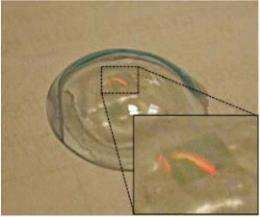Meta-flex: Your new brand for invisibility clothing

(PhysOrg.com) -- A team of physicists are one step closer to creating a Harry Potter-style invisibility cloak, with a new form of material that could also be attached to contact lenses to provide 'perfect' eyesight. Using tiny atoms that can interact with light, the St Andrews' researchers have developed a flexible new 'smart' material that could theoretically appear invisible to the naked eye.
Flexible smart materials that can manipulate light to shield objects from view have been much-theorised but now researchers in Scotland have made a practical breakthrough that brings the possibility of an invisibility cardigan – or any other item of invisibility clothing - one step closer.
Two challenges to the creation of smart flexible materials that can cloak from visible light are making meta-atoms small enough to interact with visible light, and the fabrication of metamaterials that can be detached from the hard surfaces they are developed on to be used in more flexible constructs.
Research published today, Thursday 4 November 2010, in New Journal of Physics, details how Meta-flex, a new material designed by researchers from the University of St Andrews, overcomes both of these challenges.
Although cloaks designed to shield objects from both Terahertz and Near Infrared waves have already been designed, a flexible material designed to cloak objects from visible light poses a greater challenge because of visible light's smaller wavelength and the need to make the metamaterial's constituent part – meta-atoms – small enough to interact with visible light.
These tiny meta-atoms have been designed but they have only traditionally been realized on flat, hard surfaces, making them rigid constructs impractical for use in clothing or other possible applications that would benefit from flexibility, such as super lenses.
The research team, led by EPSRC Career Acceleration Fellow Dr Andrea Di Falco, has developed an elaborate technique which frees the meta-atoms from the hard surface ('substrate') they are constructed on. The researchers predict that stacking them together can create an independent, flexible material, which can be adopted for use in a wide range of applications.
Di Falco says, "Metamaterials give us the ultimate handle on manipulating the behaviour of light. The impact of our new material Meta-flex is ubiquitous. It could be possible to use Meta-flex for creating smart fabrics and, in the paper, we show how easy it is to place Meta-flex on disposable contact lenses, showing how flexible superlenses could be used for visual prostheses."
More information: The researchers' paper can be downloaded for free here: iopscience.iop.org/1367-2630/12/11/113006/fulltext
Provided by Institute of Physics

















